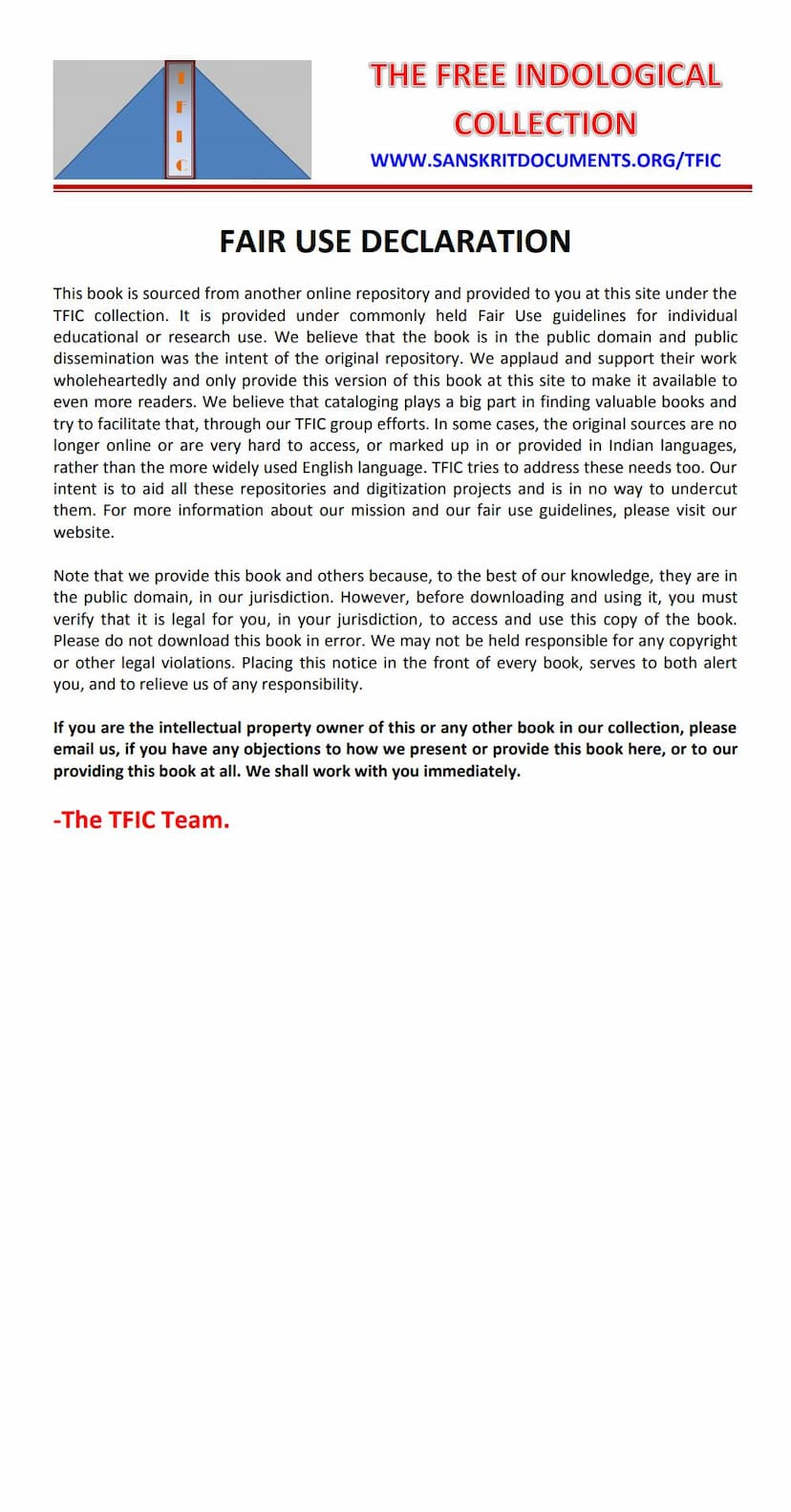Tattvarthamuktakalap And Sarvarthasiddhi
Added to library: September 2, 2025

Summary
This document contains the Sanskrit text of Tattvamuktakalapa and its commentary Sarvarthasiddhi by Vedantacharya, along with the commentary Anandadayini by Narasimharaja. This particular volume, Volume IV, focuses on the "Nayaka Sar" of the Tattvamuktakalapa.
Here's a comprehensive summary of the content based on the provided text:
Overall Context:
- Tattvamuktakalapa: This is a seminal work by Vedantacharya, a prominent philosopher and theologian of the Vishishtadvaita Vedanta tradition. It is known for its extensive treatment of various philosophical topics and refutations of opposing viewpoints. The text is divided into five sections called "Saras" (pools), namely Jadadravya Sara, Jiva Sara, Nayaka Sara, Buddhi Sara, and Adravya Sara.
- Sarvarthasiddhi: This is the author's own commentary on Tattvamuktakalapa, providing a concise yet comprehensive explanation of the original verses.
- Anandadayini: This is a commentary on Sarvarthasiddhi by Narasimharaja. The provided text specifically highlights that this volume contains Nayaka Sara along with Sarvarthasiddhi and Anandadayini.
- Publisher and Editor: The publication is from the Oriental Research Institute, University of Mysore, as part of their Sanskrit Series. The editing is done by T. T. Srinivasagopalacharya.
- Date: The publication year is 1956.
Focus of Volume IV: Nayaka Sara
The "Nayaka Sara" is the third section of Tattvamuktakalapa and, as indicated by the extensive "Table of Contents" (Vishaya Suchani) covering pages vii to xix, it is a deeply philosophical and argumentative section. The main purpose of this section is to establish the supremacy of Narayana (Vishnu) as the ultimate reality (Paratattva) and to refute various alternative philosophical positions.
Key Themes and Arguments within Nayaka Sara (as detailed in the Table of Contents):
-
God's Relationship with the Universe:
- Establishing the Parabrahman (Supreme Being) as the body (sharirakatva) and creator (kartrutva) of the universe.
- Refuting the idea of the universe being the material cause (upadana) of God.
- Explaining God's attribute of being the object of desire and knowledge (vachyatva, vedayatva).
-
Refutation of Other Philosophies:
- Arguments against non-Narayana supreme beings: The text systematically refutes the claims of various schools that posit deities other than Narayana as the Supreme Being.
- Refutation of Nyaya arguments for God: The text critiques the logical arguments (hetus) used by the Nyaya school to establish God's existence, such as arguments from causality (karyatva), design, etc. It argues that these arguments are flawed or inapplicable to the Supreme Being.
- Refutation of theories about Brahman's nature: The text debunks various theories about Brahman, including:
- Brahman as undergoing modification or transformation (vikaravatva).
- Brahman as mere existence (sanmatratva).
- Brahman as undergoing transformation for its own sport (swalilarthajeevanam).
- Brahman as affected by illusion or ignorance (savidyatva).
- Refutation of Maya and Avidya theories: The text critiques theories that rely on Maya or Avidya (ignorance) to explain the universe or its relationship with Brahman, including the views found in Pancapadika Vivarana and Chitsukhi.
- Refutation of world-illusionism (Jaganmithyatva): A significant portion of the Nayaka Sara is dedicated to refuting the doctrine that the world is ultimately unreal or illusory, particularly drawing arguments from the Advaita Vedanta school. This involves detailed analysis and critique of proofs like "that which is seen" (drushyatva) and "that which changes" (vyavartamanatva).
- Critique of Buddhist and Jain influences: The text also addresses and refutes ideas that resemble Buddhist (e.g., Shunyatva) and Jain philosophies.
-
Establishing Narayana's Supremacy through Various Proofs:
- Scriptural Authority (Shabda Pramana): The text emphasizes that the ultimate understanding of God is through scriptural revelation (Agama) and refutes the sufficiency of mere inference (Anumana).
- Pancha-Rupa (Five Forms): The text discusses the five forms of Vishnu: Para, Vyuha, Vibhava, Antaryamin, and Archa.
- Attributes of God: The text elaborates on God's perfect attributes (purna shadgunya), omnipotence, omniscience, and the nature of His will (ichha).
-
Nature of the Supreme Being:
- Incorporeality and Form: The text argues for God's transcendental (aprakrita) and eternal form, weapons, and ornaments, refuting arguments that suggest His form is merely a manifestation or subordinate to other deities.
- Omnipresence and Immanence: The text discusses how God is present everywhere and within everything.
- Causality and Non-causality: The text grapples with the apparent contradiction between God's immutability (nirvikara) and His role as the cause of the universe, explaining how this is possible through His transcendental nature and power.
Structure of the Volume:
The volume is meticulously organized to aid the reader:
- Summaries of Topics: "Sampude asmin Nayaka Sarakalapratipadya Vishaya Sangrahah" provides an overview of the subjects discussed in this section.
- Verse Indices: Lists of verses from Tattvamuktakalapa and their interpretations in Sarvarthasiddhi are provided.
- Collection of Summaries: "Sangraha Karikas" are presented, which are concise summaries of key points within the Sarvarthasiddhi.
- Indices of Terms and References: Comprehensive indices are included for verse meanings, citations from various scriptures (Pramana Akar Suchi), and authors (Grantha Kartrunam Suchi).
- Errata: An "Ashuddha Sanshodhana Patrika" (Correction Sheet) is included to address printing errors.
In essence, Volume IV of Tattvamuktakalapa and Sarvarthasiddhi is a profound philosophical treatise that meticulously argues for the unique and supreme position of Narayana within the Vedanta framework, systematically dismantling opposing viewpoints through rigorous scriptural exegesis and logical reasoning. The inclusion of multiple commentaries (Sarvarthasiddhi and Anandadayini) demonstrates the depth and scholarly tradition surrounding these texts.